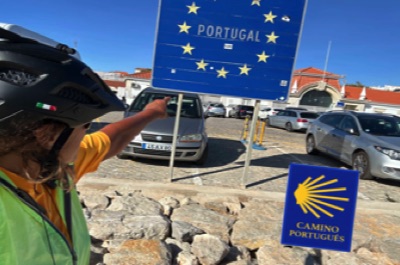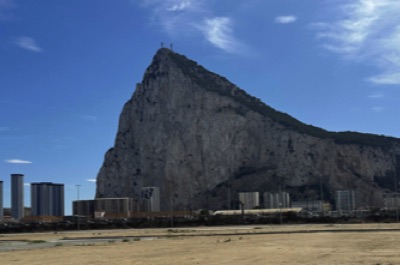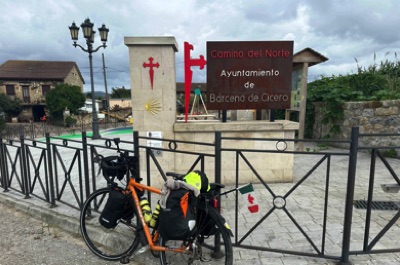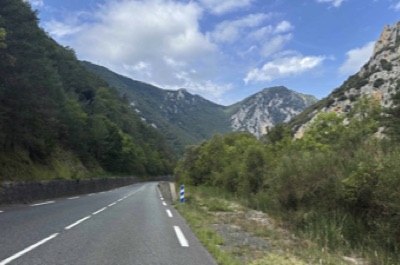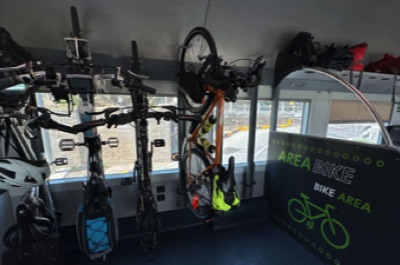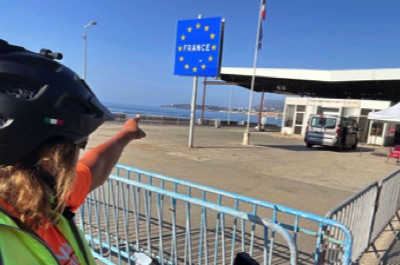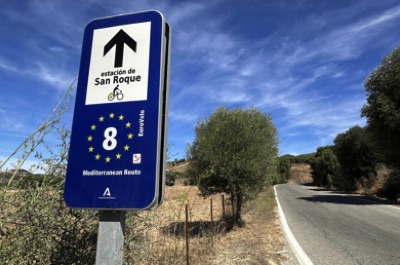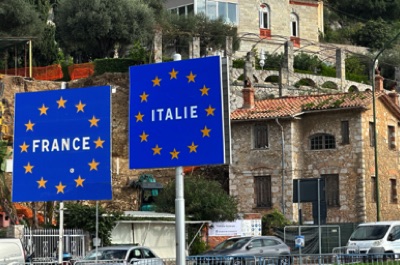
I have always dreamed of cycling the entire Iberian Peninsula and going from the sunny shores of the Mediterranean to the lush hills of the Atlantic Ocean crossing the wild expanse of the French Pyrenees mountain range which separates the Iberian Peninsula from the rest of Europe stretching between France and Spain.
Trip details
My epic solo on a fully self-supported bike tour is a full circumnavigation trip around the Iberian Peninsula took in the whole of Spain and Portugal and a crossing of the Pyrenees.
Start and end of the trip: Ventimiglia, Italy
Kilometers traveled: Cycling counterclockwise 5,714.23
Daily average: 95.24 KM
Duration and period: 60 days without a single day of rest, from August 22nd to October 20th 2024
Nations crossed: Along the entire perimeter of the Iberian Peninsula: Spain, The French Pyrenees from the Adriatic Sea to the Atlantic Ocean and Portugal, I Pedaling also from: taly and France
Which routes, paths and network roads did you use during the trip?
As an adventurer, who leaves completely independently, I have always found more interest in building my itinerary from one place to another and avoiding pre-established routes. However, on long-distance trips that often take place in remote areas, then I do a bit of detailed preparation but never completely detailed.
On trips that do not require too much preparation like this trip I use Google Map or komoot and in a few simple steps I find the daily route is a great tool for finding cycle paths and directions. And so every route I took on this trip I created my own route without ever following a set route, It’s always fun, and it’s an adventure!
What I always look for in every one of my cycle touring trips is to pedal on less busy roads and/or with good hard shoulders, I have also followed the routes recommended by locals, cycle paths such as the famous 'EuroVelo 8 or others.
I have also traveled the pilgrimage routes, which also have different meanings, such as the one through centuries-old cultures of the famous Camino de Santiago both the Camino del Norte and along the Camino Portugues Coastal Route that leads to the Cathedral of Santiago de Compostela, in the region of Galatia, in northwest Spain.
In the French Pryrenees mountains range I followed part of the La Vélosud - V81 also called Pyrenean Piedmont, The Pyrenean Route or Foothill Route is another variant that the pilgrims used to walk to reach Spain
This route is 650 km which crosses the French Pyrenees from the Mediterranean Sea in Barcarès to the Atlantic Ocean in Bayonne
What can you tell us about the adventure cycling around the Iberian Peninsula?
It was an incredible and satisfying experience to enjoy every moment with nature appreciating the variety of landscapes.It allowed me to explore the whole Iberian Peninsula and discover places I had not cycled in Spain and Portugal and It also opens up a world of opportunities to build a deeper relationship with the locals and their culture and to meet other tourists.
About the adventure
Stage1 I Milan to Ventimiglia, Italy I Day:
This incredible journey began by taking the train from Milan Central Station to Ventimiglia, a charming town on the coast of the Ligurian Riviera, located right on the coastal border between France and Italy.
Stage 2 I From the Italian Riviera crossing the French Riviera (or Côte d'Azur) into the Mediterranean Sea in the south of France, Day I:
The actual bike trip starts from Ventimiglia in the direction of Ponte San Lodovico where you enter the state border. I follow the coastal road, the first French town you come across is Menton, the beginning of the French Riviera also known as the Côte d'Azur, is a stretch of coast in the Alpes-Maritimes department that overlooks the Mediterranean Sea.
Once I pass the town of Menton there are three scenic roads to choose from, called the Basse Corniche, the Moyenne Corniche and the Grande Corniche. They are roads that run parallel to each other, with different height differences, that flow close to the mountain with splendid views of the sea that lead to Nice
I travel the road of the lower cornice and it is also the most famous that winds through breathtaking coastal landscapes and endless spectacular beaches and chaming, famous towns and villages of the Mediterranean Sea
French Riviera route has a variety of roads with cycle lanes and roads where you pedal with vehicles a varied terrain with both flat and hilly roads and beautiful landscapes and pass the municipalities of Monte Carlo and Nice with its famous Promenade des Anglais, Villeneuve-Loubet, Saint-Laurent-du-Var and Cagnes-sur-Mer, Antibes and the town of Cannes is known throughout the world for the Cannes Film Festival and also for the Promenade de la Croisette.
From here begins the famous winding stretch coastal road called La Corniche de L'Esterel also known as Corniche d'Or links the towns of Saint-Raphaël and Mandelieu-La Napoule. This route that hugs the jagged coastline with an incredible breathtaking scenery it reminded me of the cycle touring trip I had done along the famous epic rode "the California State Route 1" precisely The Big Sur region of California, USA.
Reaching Mandelieu-La Napoule I then cycled through the coastal municipalities of Fréjus, Sainte-Maxime, Port Grimaud. Continuing then inland through the municipalities of La Môle and reaching the coast again and passing through Toulon, Marseille until arriving in Martigues.
Then I take a small ferry across the Grand Rhône and via a beautiful gravel cycle-pedestrian path that crosses the beautiful Camargue natural park, passing by Les Saintes-Maraies-de-la-Mer. The sea wall (la Digue a la mer), the Gacholle lighthouse is located between the two branches of the Rhône, on the Mediterranean.
The natural park that is located near the town of Arles bordering the Mediterranean Sea is natural area has vast areas of salt marshes, marshes, kilometers of sandy beaches and also includes habitats such as wild horses, black bulls, pink flamingos and other bird species
Reached the seaside resort of La Grande-Motte and a The Sauvage ferry I took a free cable ferry for bicycles and pedestrians which connects the two banks of the Petit-Rhône, in the Camargue region.
After passing the charming town of Sète, it is a narrow promontory between the Thau lagoon and the Mediterranean Sea and is renowned for its oyster farming, surrounded by canals. I reached the seaside resort of Marseillan-Plage.
After that I crossed the Camargue National Nature Reserve in the municipalities of Arles and south of Narbonne, the Sainte-Lucie Regional Nature Reserve and finally passing through the seaside resort of Leucate, known for its kitesurfing spots and world competitions, and reaching the town of Le Barcarès, also known as Port Barcarès, located between the Mediterranea sea and the Salses-Leucate pond, a large lagoon located on the slopes of the Pyrénées Orientale
Stage 3 I French Pyrenees Coast to Coat I Day:
The route then leaves the Adriatic Sea level at the town of Barcarès, then follows the greenway along the Agly River to the town of Rivesaltes, continuing on the Piémont Pyrenéen route which runs along the foothills of the Pyrenees and passes through an extraordinary diversity of landscapes, mountain views, gorges, valleys and rivers, passing through extraordinary villages, cities such as Lourdes, a famous place of pilgrimage and cultures from each territory, and which connects to the Atlantic Ocean at the city of Bayonne. This route travels through the departments of Hérault, Aude, Ariège, Hautes-Pyrénées, and Pyrénées-Atlantiques.
Obviously there are many variants to cross the montan range but the purpose of this trip was not to climb the highest and most spectacular peaks of the legendary passes of the Tour de France it was just for me to cross and continue the journey that I had set out that was cycling the entire Iberian Peninsula.
After leaving behind BayonneI follow the spectacular French Atlantic coast of the Basque Country I passed the seaside resort of Angelet, Biarritz, a paradise for surfers, to the fishing village of Saint-Jean-de-Luz and then crossed the bridge which is located above the mouth of the river Bidasoa which connects Hendaye to Irun is a Spanish city that borders the Cantabrian Sea in the Basque Country and is located on the border between France and Spain. It is also the starting point of the Camino del Norte.
Stage 4 The Northern Coastal Route of Spain, also known as the Camino del Norte or Coastal Way from est to west to Santiago Caampostella and a ferry ride from A Garda to Caminha in Portugal I Day:
In this stretch of route I followed from Irún the northern Spain from east to west the pilgrimage route of the Camino del Norte and it is a very different experience to a cycling route in the rest of Spain, precisely because it is characterized by lush, green and wild landscapes, with rugged coastal views, pristine sandy beaches, picturesque fishing villages and a rich cultural heritage. The route is known for its challenging terrain, especially in the early stages, and features different types of terrain, with steep climbs and descents, considered among the most challenging of the route. It is on a very varied terrain, offering a mix of coastal beauty and hilly landscapes.
This spectacular route that he weather changes very quickly, in one day you get to experience different seasons passes through the regions of the Basque Country, Cantabria, Asturias and Galicia. Along the way you pass through charming and historical towns of Sebastián (Donostia), Bilbao, Santander, Gijón and Ribadeo on the Atlantic Sea located in the province of Lugo in Galicia.
Once leaving the picturesque coastal town of Ribadeo the route heads towards the interior of Galicia, passing through quiet countryside, mountainous landscapes and, with the various ups and downs of the route, heading south to the end point of the lovely, historic Santiango de Campostella, the Cathedral where the final resting places of St James the Apostle located in the north-western Spanish region of Santiago de Compostela, Galicia.
At this point and also the terminus of the famous The Camino Portuguese Coastal Route but in my case it is a continuation of the Camino del Norte switching over to The Camino Portuguese Coastal Route and continuing to cycle the circumnavigatio route of the Iberian Peninsula.
Then I cycled from Santiago de Compostela l the route head to charming towns and villages such as Padrón, Pontevedra and Redondela. After a spectacular stretch of rugged coastline and a small mountain, I reach the charming coastal towns of Vigo and Baiona, continuing the Camino de Santiago until arriving in A Garda. It is where a short ferry of 15 minutes ride across the River Minho leaves Spanish territory entering the coastal region in northwestern Portugal in the town of Caminha.
Stag 5 I The Coastal Route of the Camino Portugués from north to south and The Algarve Coast Route from east to west I Day:
After that I left the charming coastal town of Caminha perched on Portugal's northern border and from there the route headed south following The Coastal Route of the Portuguese Camino. This coastal area is also called "Costa Verde" for the thick vegetation of the lush landscape due to the abundant rainfall and the coastal road passes through small towns and fishing villages such as Viana do Castelo, Esponende until arriving at the World Heritage city of Porto.
After a short visit to the city of Porto and crossing the famous bridge "D. Luis I cycled to Vila Nova de Gaia passing other coastal towns such as Figueira da Foz and reaching the picturesque fishing village of Nazaré, it is a world-famous surfing destination famous for its giant waves at Praia do Norte beach.
After leaving the village of Nazaré, I continued passing through other coastal towns and then heading to discover the hinterland where it is less touristic until reaching the town of Torres Vedras, located not far from the sea but it's not a coastal town directle. The historic centreis located in the district of Lisbon, has a castle and romantic small streets and cozy squares. After that I cycled for about 60 kilometers I reached the coastal and hilly capital of Liblona.
After leaving the western part of Lisbon and the Belém ferry terminal I took the ferry across the Tagus River to the fishermen's village of Trafaria, where the river meets the sea. Then I cycled into the hidden heart of the Costa da Caprica, in the Setúbal peninsula, with beautiful wide and flat beaches and plenty of cycle paths to explore.
After cycling on scenic trails in the Amora area, with many sandy trails and large pine forests, but unfortunately in the previous days the forest fires had burned much of the area which was still a fascinating and deserted route.
Then a short ferry ride from Setúbal to Tróia, cycling on the Eurovelo 1 cycle path that crosses the Tróia peninsula to the village of Comporta, located at the foot of the peninsula.
Continuing the EuroVelo along the beautiful Alentejo coast, I pass by the coastal town of Sines and then I left it continuing south on an internal and slightly mountainous road route to discover the hinterland of the Alentejo, passing through the ancient village of Cercal do Alentejo (the beautiful beaches are not far away, certainly not by bike), located in a still uncontaminated and not very touristy place, to then reach the most famous coastal resort of the town of Vila Nova de Milfontes, continuing I pass by the village of Boavista dos Pinheiros, from the locality of S. Teotónio, which is located in the south-western Alentejo and is part of the Costa Vicentina Natural Park, near the border with the Algarve and a few kilometers from the coastal town of Zambujeira do Mar, known for its natural and enchanting beaches surrounded by steep cliffs.
After that I pass the small village of Odeceixe, located along the Seixe River, which marks the border between the provinces of Alentejo and Algarve. And it is the first Algarvian village on the Vicentine coast.
After leaving Odeceixe behind, I cycled inland through the rolling hills of the Algrave countryside arriving at the village of Bensafrims before reaching the western part of the Algrave is famous for being one of the sunniest regions in Europe, south of Portugal.
And from the picturesque southwestern part of the Algarve region passed from the first coastal locality of Logos then on to Portimão, Lagoa and other locality sush as Almancil, Faro, Portimão, Olhão, Tavira and finally to the town of Vila Real de Santo Antonio in the eastern Algarve where I took a short 15 minute ferry across the Guardiana River in Portugal to the town of Ayamonte on the Costa de la Luz, in Huelva province, Andalusia in southwest Spain.
Stage 6 I Ayamonte on the Atlantic coast of Andalusia in Spain and the Strait of Gibraltar connects the Mediterranean Sea with the Atlantic Ocean and separates southernmost Spain Day:
IIn this part of the route, which begins after leaving behind the city of Ayamonte in Spain, passing through the port city of Huelve and reaching the beautiful and fascinating city of Seville, capital of Andalusia.
The route then continues in the province of Cadiz, on the Costa de la Luz, bathed by the Atlantic Ocean reaching El Puerto de Santa María, is a town and historically linked to Cristóbal Colón, especially on trips to America. It is located northeast of Cádiz, across the bay of Cádiz.
Continuing along the coast until reaching the southernmost tip of the Iberian Peninsula where is located the of Tarifa, famous among lovers of wind sports, then I reach La Línea de la Concepción, is a coastal border town, in the province of Cádiz, Andalusia and is where Spain meets Gibraltar is an Overseas Territory of the United Kingdom and It's dominated by the Rock of Gibraltar. I had made a short visit to Gibraltar, since I had already visited it during another cycling trip.
Stage 7 I The Strait of Gibraltar and along the Mediterranean coast of Spain from east to west to the town of Jonquera in Catalonia, Spain near the French border I Day:
After leaving Gibraltar and the Gibraltar Strait, a channel that connects the Atlantic Ocean to the Mediterranean Sea and separates Europe from Africa.
After that I cycled along the beautiful Mediterranean Coast from west to east of Spain on the EuroVelo cycle route and others encountered crossing the varied landscapes, rich history, culture and charming coastal cities. In addition you pass Enchanting seaside resort a succession of beaches but also rocky coasts and even desert routes.
After having traveled to the region of Andalusia on the Atlantic Coast of the Costa de la Luz I continued on the same coast but the one bathed by the Adriatic Sea then the Costa del Sol, the Costa Granadina, the Costa Almeria, the Costa Cálida, the Costa Blanca, the Costa del Valencia, the Costa Daurada, the Costa del Maresme and lastly the Costa Brava up to La Jonquera, located near the border with Northern Catalonia in Spain. It is the end of my incredible and unforgettable journey in the Iberian Peninsula
Stage 8 I Leaving the town of Jonquera in Spain and cycling along the Cote d'Azur (French Riviera) in France until reaching the town of Ventimiglia in Italy I Day:
The penultimate leg of the journey, after crossing the border at La Jonquera, I cycled along the French Riviera (Côte d'Azu) in the south of France. The route is a combination of coastal roads and cycle paths, including the EurioVelo 8 route offering panoramic views of the Mediterranean coast, passing through historic towns, small villages and cities like Perpignan, Le Barcarès and Cannes famous for the Film Festival,.
Some sections of the road were repetitive to those on the outward journey although the one really different was that after cycling along the Promenade des Anglais, it is a boulevard by the sea in Nice.
Then from the heart of the city of Nice I cycled the Grande Corniche it is a higher panoramic route that offers views of the Alpes-Maritimes and especially the coast and starts from the heart of Nice all the way to Menton on the Italian border. t is located at over 400 meters above sea level and is the oldest road, built by order of Napoleon I, reaching the final stage of the journey in the starting point of the pretty town of Ventimiglia in the province of Imperia, in Liguria, in Northern Italy.
After a farewell to the Italian Riviera I took the train back to Milan!
ROUTE STAGE 3 I THE FRENCH PYRENEES COAST TO COAST
The route then leaves the Adriatic Sea level at the town of Barcarès, then follows the greenway along the Agly River to the town of Rivesaltes, continuing on the Piémont Pyrenéen route which runs along the foothills of the Pyrenees and passes through an extraordinary diversity of landscapes, mountain views, gorges, valleys and rivers, passing through extraordinary villages, cities such as Lourdes, a famous place of pilgrimage and cultures from each territory, and which connects to the Atlantic Ocean at the city of Bayonne. This...
ROUTE STAGE 4 I THE NORTHEN COAST OF SPAIN FROM EST TO WEST
In this stretch of route I followed from Irún the northern Spain from east to west the pilgrimage route of the Camino del Norte and it is a very different experience to a cycling route in the rest of Spain, precisely because it is characterized by lush, green and wild landscapes, with rugged coastal views, pristine sandy beaches, picturesque fishing villages and a rich cultural heritage. The route is known for its challenging terrain, especially in the early stages, and features different types of terrain, with steep climbs and descents, considered among...
ROUTE STAGE 5 I PORTUGAL FROM NORTH TO SOUTH AND INCLUDING THE ALGARGE COAST FROM EAST TO WEST
After that I left the charming coastal town of Caminha perched on Portugal's northern border and from there the route headed south following The Coastal Route of the Portuguese Camino. This coastal area is also called "Costa Verde" for the thick vegetation of the lush landscape due to the abundant rainfall and the coastal road passes through small towns and...
ROUTE STAGE 7° I The Strait of Gibraltar and along the Mediterranean coast of Spain from east to west to the town of Jonquera in Catalonia, Spain near the French border
In this stage of the journey I cycle After leaving Gibraltar and the Gibraltar Strait, a channel that connects the Atlantic Ocean to the Mediterranean Sea and separates Europe from Africa.
After that I cycled along the beautiful Mediterranean Coast from west to east of Spain on the EuroVelo 8 cycle route and others encountered crossing the varied landscapes, rich...
ROUTE STAGE 8° I Leaving the town of Jonquera in Spain and cycling along the Cote d'Azur (French Riviera) in France until reaching the town of Ventimiglia in Italy
Cycling the end of my incredible and unforgettable journey in the Iberian Peninsula ended in La Jonquera, located near the border with Northern Catalonia, Spain and cycling in France to the Italian border in the city of Ventimiglia which overlooks the sea in the far western Liguria.
ROUTE STAGE 1 I MILAN TO VENTIMIGLIA IN ITALY
This stage of my cycling trip began in Milan and from the Central Station I took the train to Ventiniglia in the Lombardy region of northern Italy. I had booked the trip a few days in advance because you might not find space for your bicycle and you would need to purchase an additional ticket for transporting your bicycle.
The train journey was approximately 3 hours and...
MAP coming soon
ALL THE STAGES OF THE TOUR AND VIDEOS
Cycle Tour I Circumnavigation the Iberian Peninsula I Spain and Portugal
STAGE 2 I From the Italian Riviera crossing the French Riviera (or Côte d'Azur) into the Mediterranean Sea in the south of France
The actual bike trip starts from Ventimiglia in the direction of Ponte San Lodovico where you enter the state border. I follow the coastal road, the first French town you come across is Menton, the beginning of the French Riviera also known as the Côte d'Azur, is a stretch of coast in the Alpes-Maritimes department that overlooks the Mediterranean Sea...
ROUTE STAGE 6 I SPAIN & GIBRALTAR
In this part of the route, which begins after leaving behind the city of Ayamonte in Spain, passing through the port city of Huelve and reaching the beautiful and fascinating city of Seville, capital of Andalusia.
The route then continues in the province of Cadiz, on the Costa de la Luz, bathed by the Atlantic Ocean reaching El Puerto de Santa María, is a town and historically linked to....
